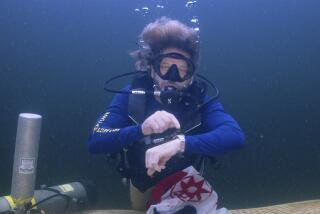Pure Oxygen May Aid Heart Attack Victims : Medicine: Preliminary research finds that pressurized chamber used to treat ‘the bends’ in divers can lessen chest pain and help keep cardiac muscle tissue alive.
- Share via
Dr. George Hart is a retired Navy physician who makes his living operating on people’s hearts and lungs. Twelve years ago, as he lay in the emergency room at Long Beach Memorial Medical Center after suffering a heart attack while driving to work, the cardiovascular surgeon took his treatment into his own hands.
He ordered his nurse to put him in a hyperbaric oxygen chamber--the kind used to treat deep sea divers who suffer from decompression illness, known as “the bends.” Within 30 minutes, Hart said, the intense pain in his chest was gone.
That experience in September, 1980, led Hart on a quest to determine if emergency treatment in pressurized hyperbaric chambers is beneficial to heart attack patients. Today, at an annual scientific conference hosted by the American Heart Assn. in New Orleans, he and his colleagues are scheduled to report that their preliminary studies show that the treatment works.
In a study of 49 patients who had just suffered heart attacks, physicians at Long Beach Memorial found that use of hyperbaric chambers, when combined with clot-dissolving drugs, relieved chest pain and significantly reduced damage to the heart muscle contrasted with administering the drugs alone.
In some heart attacks, blood clots close off the coronary artery, cutting off oxygen to the heart and causing the muscle to scar. Decades ago, doctors theorized that hyperbaric oxygen chambers--in which patients are provided with pure oxygen--might help prevent this scarring.
Studies in this area were abandoned with the introduction of clot-dissolving drugs in the 1970s. Yet, according to Dr. Myrvin Ellestad, who directed the Long Beach Memorial research, the drugs can take two hours to dissolve the clots, during which time the heart usually sustains damage because of continued oxygen deficiency.
In the hyperbaric chamber, Ellestad said, patients receive oxygen at twice the normal atmospheric pressure, which increases the blood’s oxygen level by about 15 times. “This very high oxygen level penetrates everything in the body, and we think it stops the damage in the heart during the time the medicine is dissolving.”
The clinical trials followed an animal study about 10 years ago in which a Cleveland researcher, spurred by Hart’s 1980 experience, induced heart attacks in dogs and treated some with hyperbaric oxygen.
The researcher later dissected the animals’ hearts and found that dogs that received oxygen treatment and clot-dissolving drugs sustained damage to just 5% of their heart muscle. By contrast, dogs that were treated with clot-dissolving drugs or oxygen alone sustained damage to 50% of the heart muscle.
In the randomized human trials at Long Beach Memorial, doctors treated 24 patients with clot-dissolving agents only and 25 with the drugs and oxygen chamber. They found that electrocardiogram tests of patients who received the oxygen treatment showed that the heart resumed normal electrical activity twice as fast as in patients who were not placed in the chambers.
Moreover, patients who received the oxygen had significantly lower levels of the enzyme creatine phosphokinase, which is released during a heart attack and indicates the extent of heart muscle damage. And the doctors found that the heart’s “ejection fraction”--its ability to pump blood-- was increased by about 5% with the oxygen treatment contrasted with the drugs-only therapy.
The treatment may have some drawbacks. Most hospitals are not equipped with hyperbaric chambers, which cost about $80,000 and are used to treat stroke victims and speed healing of wounds. In addition, medical personnel would have to be trained in their use.
And one heart expert, Dr. Joseph Ornato of the Medical College of Virginia, said putting patients in the chambers may be risky because doctors and nurses might not be able to monitor the patients adequately in the event of an emergency, such as a second heart attack.
Ornato called the study an “interesting, yet relatively preliminary observation.”
Ellestad agreed, saying he would like to study at least 1,000 patients. “We’re enthusiastic about the treatment, although we are the first to admit that you need a lot more patients before it is totally proven.”
But the 62-year-old Hart, who said his family has a history of heart trouble, is convinced. Hart said he has had several heart surgeries--including a quadruple bypass--since his 1980 heart attack, and that his heart has suffered little damage except for an incident during a trip overseas where the hospital that treated him did not have a hyperbaric chamber.
“Now,” he said, “I don’t plan to visit too many places unless they have immediate availability of a hyperbaric chamber.”






